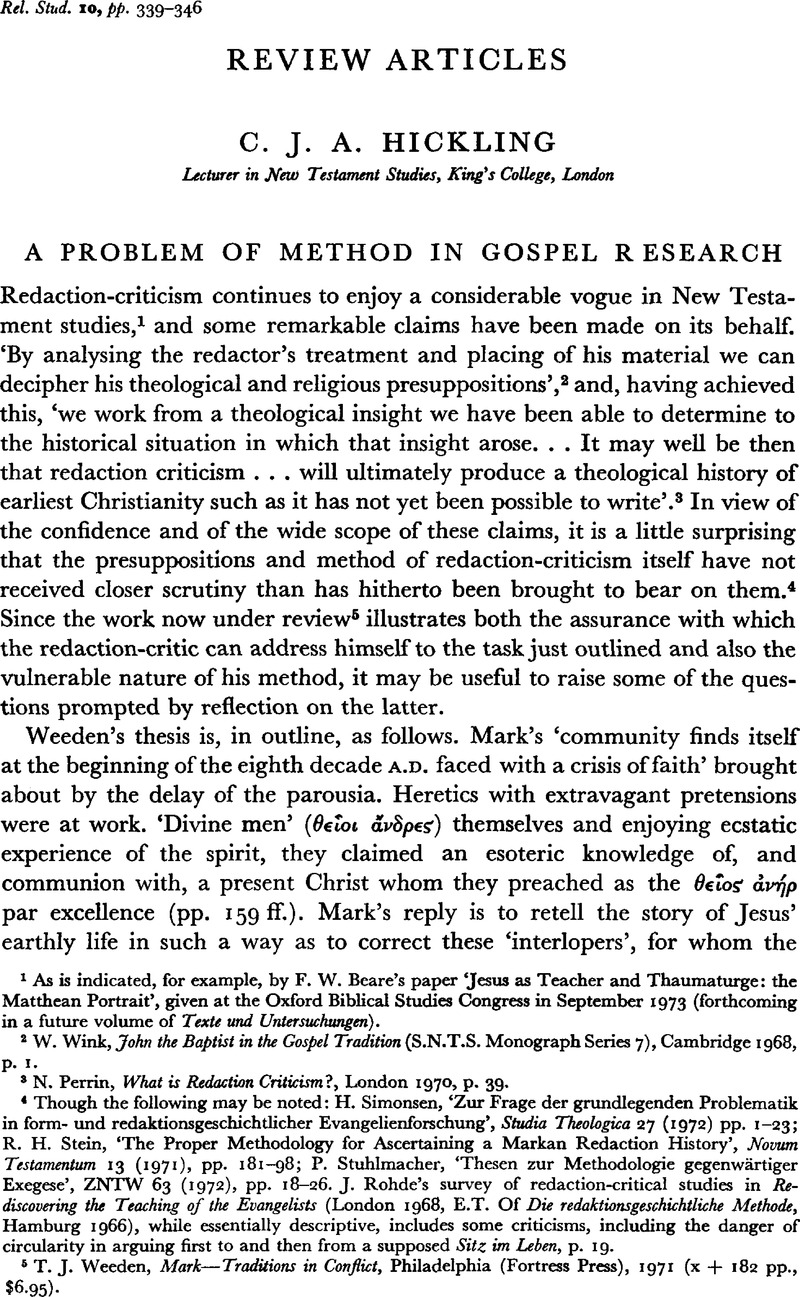No CrossRef data available.
Article contents
A Problem of Method in Gospel Research
Published online by Cambridge University Press: 24 October 2008
Abstract

- Type
- Review Articles
- Information
- Copyright
- Copyright © Cambridge University Press 1974
References
page 339 note 1 As is indicated, for example, by F. W. Beare's paper ‘Jesus as Teacher and Thaumaturge: the Matthean Portrait’, given at the Oxford Biblical Studies Congress in September 1973 (forthcoming in a future volume of Texte und Untersuchungen).
page 339 note 2 Wink, W., John the Baptist in the Gospel Tradition (S.N.T.S. Monograph Series 7), Cambridge 1968, p. 1.Google Scholar
page 339 note 3 Perrin, N., What is Redaction Criticism?, London 1970, p. 39.Google Scholar
page 339 note 4 Though the following may be noted: Simonsen, H., ‘Zur Frage der grundlegenden Problematik in form- und redaktionsgeschichtlicher Evangelienforschung’, Studia Theologica 27 (1972) pp. 1–23Google Scholar; Stein, R. H., ‘The Proper Methodology for Ascertaining a Markan Redaction History’, Novum Testamentum 13 (1971), pp. 181–98CrossRefGoogle Scholar; Stuhlmacher, P., ‘Thesen zur Methodologie gegenwärtiger Exegese’, ZNTW 63 (1972), pp. 18–26.Google ScholarRohde's, J. survey of redaction-critical studies in Rediscovering the Teaching of the Evangelists (London 1968, E.T. Of Die redaktionsgeschichtliche Methode, Hamburg 1966), while essentially descriptive, includes some criticisms, including the danger of circularity in arguing first to and then from a supposed Sitz im Leben, p. 19.Google Scholar
page 339 note 5 Weeden, T. J., Mark—Traditions in Conflict, Philadelphia (Fortress Press), 1971 (x + 182 pp., $6.95)Google Scholar
page 341 note 1 Nineham, D. E., Saint Mark (Pelican New Testament Commentaries), Harmondsworth 1963, p. 37.Google Scholar Much of Hooker's, M. D.Son of Man in Mark (London 1967) is devoted to showing how both sides of the paradox are held together by Mark's use of the title ‘Son of Man’.CrossRefGoogle Scholar
page 341 note 2 Cp. Quesnell, Q., The Mind of Mark (Analecta Biblica 38), Rome 1969, pp. 156–75.Google Scholar
page 341 note 3 Dibelius', well-known phrase in From Tradition to Gospel (ET of Die Formgeschichte des Evangeliums, 1933), London 1934, p. 43.Google Scholar
page 341 note 4 Trocmé, E., ‘Is there a Marcan christology?’, in Christ and Spirit in the New Testament, ed. Lindars, B. and Smalley, S. S., Cambridge 1973, pp. 10 f.Google Scholar
page 342 note 1 Georgi's, D.Die Gegner des Paulus im 2. Korintherbrief (Neukirchen-Vluyn, 1964) has been influential in a number of subsequent works on that epistle. Weeden refers to his proposals, and indeed draws a parallel—as others have done—between Paul's situation vis-à-vis heretical opponents and Mark's.Google Scholar
page 342 note 2 ‘Towards the Isolation of Pre-Markan Miracle Catenae’ and ‘The Origin and Function of the Pre-Marcan Miracle Catenae’, J. B. L. 89 (1970) pp. 265–91, and 91 (1972), pp. 198–221 (the latter is not referred to by Weeden).Google Scholar
page 342 note 3 Cp. the detailed and well-argued proposals of Knox, W. L. in The Sources of the Synoptic Gospels (edited by Chadwick, H.), Volume I: St Mark, Cambridge 1953.Google Scholar The attempt to detect sources behind Mark remains, of course, tentative and controversial, cp. Güttgemanns, E., Offene Fragen Zur Formgeschichte des Evangeliums, München 1970, pp. 223–31.Google Scholar
page 343 note 1 It is in any case doubtful whether this term can legitimately be used in the confident way in which it appears in much recent writing, cp. Moule, C. F. D., ‘The Distinctiveness of Christ,’ Theology LXXVI No. 641, p. 563Google Scholar, and Tiede, D. L., The Charismatic Figure as Miracle Worker, S. B. L. Dissertation Series 1, Montana 1972, there cited.Google Scholar
page 343 note 2 Cp. Stuhlmacher, P., art. cit. p. 22.Google Scholar
page 343 note 3 Winter, P., Deutsche Literaturzeitung 89 (1968), col. 784Google Scholar, quoted in Vermes, G., Jesus the Jew, London 1973, p. 186.Google Scholar
page 343 note 4 In Mark—Evangelist and Theologian, Exeter 1972, which admirably surveys recent studies on this gospel before presenting his own carefully-argued and largely persuasive views.
page 344 note 1 Robinson, J. M., The Problem of History in Mark (Studies in Biblical Theology, First Series, 21), London 1957, p. 54.Google Scholar
page 344 note 2 Cp. Marxsen, W., Introduction to the New Testament (ET of Einleitung in das neue Testament, Gütersloh 1964), Oxford 1968, pp. 143 f.Google Scholar
page 344 note 3 As is implied by Marxsen, W., op. cit., p. 138Google Scholar, and earlier in his Der Evangelist Markus (ET Mark the Evangelist, Nashville 1969), pp. 77–101.
page 345 note 1 Op. cit. p. 1. (italics mine).
page 345 note 2 In The Logic of Gospel Criticism, London 1968, pp. 157–61.Google Scholar It should be noted, however, that in spite of its date this work gives no attention specifically to redaction-criticism.
page 345 note 3 Cp. Stein, R. H., art. cit. pp. 185 ff.Google Scholar
page 345 note 4 Cp. Simonsen, H., art. cit. pp. 18, 21.Google Scholar K. Koch has also stressed the interpretative rather than creative role of the redactor, as of the tradent at the oral stage, see The Growth of the Biblical Tradition (ET of Was ist Formgeschichte?, Neukirchen 1964), London 1969, pp. 57 ff.
page 346 note 1 This last point forms an important part of Güttgemanns' comments on form-, and by implication also on redaction-criticism, op. cit. sections III and IV.
page 346 note 2 See notes 16 and 9 respectively.


